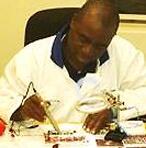Invited Speaker---Dr. Kant Kanyarusoke

Dr. Kant Kanyarusoke, Cape Peninsula University of Technology, South Africa.
Speech Title: Solar water purifiers for small rural African homesteads: Evaluation of alternative designs
Abstract: Energy and water are twin utilities whose provision are problematic in rural Africa. Over 681 Million rural African people have no access to modern forms of energy while nearly 319 Million also have no reliable drinking water. This population largely relies on combustion of biomass for thermal energy sourcing, raising health and environmental issues. Water is sourced from stagnant ponds or from streams, often used by domestic and wild animals as well. When sourced from boreholes, it is often brackish and may have undesirable dissolved salts. From whichever source, it is a frequent medium for many diseases, which are a serious problem on the continent. To overcome some of these problems, some homes filter and boil the water for drinking. But this aggravates the energy problem and leaves dissolved inorganic salts in solution. Thus, heating to decontaminate the water forms a confluence of the Energy and Water twin problems. This paper describes part of the work to address the confluence. Five different systems converting solar energy to thermal energy for water purification had been designed and constructed. Two of them employed external still condensation while three had internal condensation, with one of them tracking the sun in the East-West direction. Daily water collection was monitored over a two week period, and weather data was logged at 15 minute intervals. Comparative performance was evaluated based on different criteria: daily Litre yield per square metre glazing (L/m2); overall Litre yield per kWh incident radiation (L/kWh); Overall Litre yield per 1000 Rand material cost (L/KR); first law thermal efficiency (%). As expected, it was found that the tracking unit out performed its closest rivals in L/m2 by a factor of 27%. However, it underperformed on all the other parameters mainly because of increased condensate drop backs into the still. On cost, it underperformed the least costly by a factor of 11% because of the tracking device elements. It was therefore concluded that tracking – as existed in one of the prototypes – might not be a suitable choice for most rural homesteads. However, if it could be simplified, e.g. by making it manual, it could be worthwhile.

